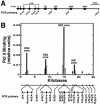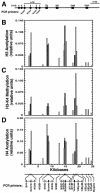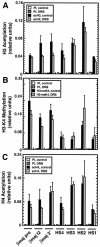Highly restricted localization of RNA polymerase II within a locus control region of a tissue-specific chromatin domain
- PMID: 12944475
- PMCID: PMC193707
- DOI: 10.1128/MCB.23.18.6484-6493.2003
Highly restricted localization of RNA polymerase II within a locus control region of a tissue-specific chromatin domain
Abstract
RNA polymerase II (Pol II) can associate with regulatory elements far from promoters. For the murine beta-globin locus, Pol II binds the beta-globin locus control region (LCR) far upstream of the beta-globin promoters, independent of recruitment to and activation of the betamajor promoter. We describe here an analysis of where Pol II resides within the LCR, how it is recruited to the LCR, and the functional consequences of recruitment. High-resolution analysis of the distribution of Pol II revealed that Pol II binding within the LCR is restricted to the hypersensitive sites. Blocking elongation eliminated the synthesis of genic and extragenic transcripts and eliminated Pol II from the betamajor open reading frame. However, the elongation blockade did not redistribute Pol II at the hypersensitive sites, suggesting that Pol II is recruited to these sites. The distribution of Pol II did not strictly correlate with the distributions of histone acetylation and methylation. As Pol II associates with histone-modifying enzymes, Pol II tracking might be critical for establishing and maintaining broad histone modification patterns. However, blocking elongation did not disrupt the histone modification pattern of the beta-globin locus, indicating that Pol II tracking is not required to maintain the pattern.
Figures







Similar articles
-
The beta -globin locus control region (LCR) functions primarily by enhancing the transition from transcription initiation to elongation.Genes Dev. 2003 Apr 15;17(8):1009-18. doi: 10.1101/gad.1072303. Epub 2003 Apr 2. Genes Dev. 2003. PMID: 12672691 Free PMC article.
-
Synergistic and additive properties of the beta-globin locus control region (LCR) revealed by 5'HS3 deletion mutations: implication for LCR chromatin architecture.Mol Cell Biol. 2005 Aug;25(16):7033-41. doi: 10.1128/MCB.25.16.7033-7041.2005. Mol Cell Biol. 2005. PMID: 16055715 Free PMC article.
-
Developmental stage differences in chromatin subdomains of the beta-globin locus.Proc Natl Acad Sci U S A. 2004 May 4;101(18):7028-33. doi: 10.1073/pnas.0307985101. Epub 2004 Apr 22. Proc Natl Acad Sci U S A. 2004. PMID: 15105444 Free PMC article.
-
ChIPs of the beta-globin locus: unraveling gene regulation within an active domain.Curr Opin Genet Dev. 2002 Apr;12(2):170-7. doi: 10.1016/s0959-437x(02)00283-6. Curr Opin Genet Dev. 2002. PMID: 11893490 Review.
-
Histone acetylation beyond promoters: long-range acetylation patterns in the chromatin world.Bioessays. 2001 Sep;23(9):820-30. doi: 10.1002/bies.1117. Bioessays. 2001. PMID: 11536294 Review.
Cited by
-
Recruitment of transcription complexes to enhancers and the role of enhancer transcription.Biology (Basel). 2012 Dec 5;1(3):778-93. doi: 10.3390/biology1030778. Biology (Basel). 2012. PMID: 23919179 Free PMC article.
-
Nucleosome and transcription activator antagonism at human beta-globin locus control region DNase I hypersensitive sites.Nucleic Acids Res. 2007;35(17):5831-8. doi: 10.1093/nar/gkm620. Epub 2007 Aug 24. Nucleic Acids Res. 2007. PMID: 17720709 Free PMC article.
-
Identification of the Drosophila X chromosome: The long and short of it.RNA Biol. 2015;12(10):1088-93. doi: 10.1080/15476286.2015.1086864. Epub 2015 Sep 14. RNA Biol. 2015. PMID: 26367502 Free PMC article. Review.
-
The locus control region activates serpin gene expression through recruitment of liver-specific transcription factors and RNA polymerase II.Mol Cell Biol. 2007 Aug;27(15):5286-95. doi: 10.1128/MCB.00176-07. Epub 2007 May 25. Mol Cell Biol. 2007. PMID: 17526725 Free PMC article.
-
Ikaros interacts with P-TEFb and cooperates with GATA-1 to enhance transcription elongation.Nucleic Acids Res. 2011 May;39(9):3505-19. doi: 10.1093/nar/gkq1271. Epub 2011 Jan 17. Nucleic Acids Res. 2011. PMID: 21245044 Free PMC article.
References
-
- Agalioti, T., G. Chen, and D. Thanos. 2002. Deciphering the transcriptional histone acetylation code for a human gene. Cell 111:381-392. - PubMed
-
- Bender, M. A., M. Bulger, J. Close, and M. Groudine. 2000. Beta-globin gene switching and DNase I sensitivity of the endogenous beta-globin locus in mice do not require the locus control region. Mol. Cell 5:387-393. - PubMed
-
- Brownell, J. E., J. Zhou, T. Ranalli, R. Kobayashi, D. G. Edmondson, S. Y. Roth, and C. D. Allis. 1996. Tetrahymena histone acetyltransferase A: a homolog to yeast Gcn5p linking histone acetylation to gene activation. Cell 84:843-851. - PubMed
Publication types
MeSH terms
Substances
Grants and funding
LinkOut - more resources
Full Text Sources
Other Literature Sources
Research Materials
